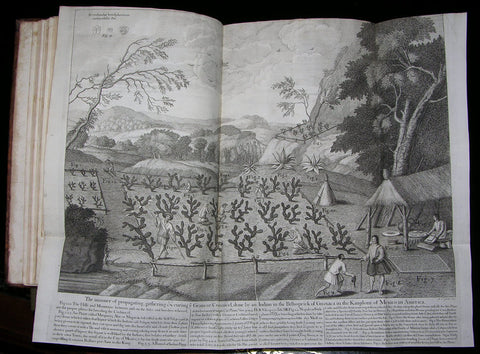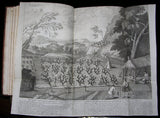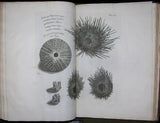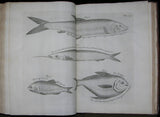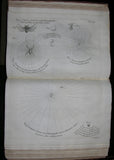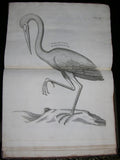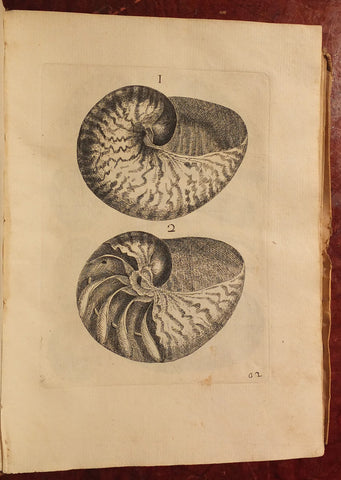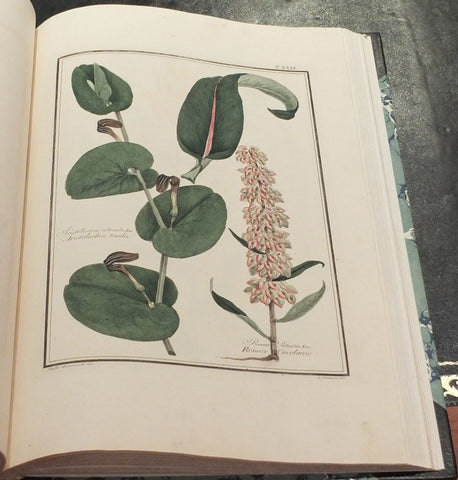Sir Hans Sloane (1600-1753), A Voyage to the Islands Madera, Barbados, Nieves, S. Christophers and Jamaica...
Sir Hans Sloane (1600-1753)
A Voyage to the Islands Madera, Barbados, Nieves, S. Christophers and Jamaica, with the natural history of the herbs and trees, four-footed beasts, fishes, birds, insects, reptiles, &c. of the last of those islands; to which is prefix'd, an introduction, wherein is an account of the inhabitants, air, waters, diseases, trade, &c. of that place, with some relations concerning the neighbouring continent, and islands of America. Illustrated with figures of the things described, which have not been heretofore engraved. In large copper-plates as big as the life.
London: Printed by B. M[otte], for the author, 1707-1725
2 volumes. Folio (13 3/8 x 9 3/4 inches). Title-pages printed in red and black, folding engraved map of the Atlantic Ocean, Caribbean, and Jamaica, 284 double-page, including 31 folding, magnificent engraved plates of the exotic botanical, marine and bird life of the West Indies, after E. Kickius and G. Moore by M. vander Gucht and J. Savage, text and plates all mounted on guards (7 plates a bit browned). Contemporary speckled calf, the spines in seven compartments with six raised bands, citron and black morocco lettering (expertly rebacked preserving the original spines, covers darkened).
Provenance: with the bookplate of Jared Potter Kirtland (1793-1877) of Cleveland, Ohio on the front paste-down of each volume
First edition of the first published descriptions and illustrations of the flora and fauna of Jamaica and "a fundamental work for West Indian botany" (Great Flower Books).
This book provides a remarkable descriptive and visual account of the travels and observations made by Sir Hans Sloane (1660-1753) while he was in Jamaica. "Sloane went to Jamaica in 1687 as physician to the Duke of Albermarle, the newly appointed governor. Before his departure he had compiled a list of animal and plant specimens required by friends such as the English naturalist John Ray (1627-1705). During the fifteen months he was there he also assembled for himself a fine collection of plants, insects, shells, fish and other specimens...When he returned to London, Sloane tried to bring back live animals from Jamaica. Sadly the ‘guana' (lizard) fell overboard, the crocodile died, and a yellow snake escaped and was shot. But the descriptions and illustrations in his book provide us with important information about Jamaican vertebrates. He describes, for example, how the snakes were useful for destroying the black rats that had arrived on European ships and ate the sugar cane. Later when the snakes couldn't keep pace with the rats, Indian mongoose were imported but they were so effective that the snakes faced starvation. The mongoose also ate many lizards that were native to the islands. Sloane described and illustrated one of these, the great galliwasp, which later became extinct" (K. Sloan (ed.), Enlightenment. Discovering the (London, The British Museum Press, 2003).
Later Sloane was personal physician to Queen Anne and George I, but while in Jamaica he fulfilled the role of gentleman naturalist. Sloane reports that he took pains 'to search the several Places I could think afforded Natural Productions, and immediately described them in a Journal'. "He made notes on the weather, the topography, natural phenomena such as earthquakes, but above all on the flora, penetrating to the north of the island collecting, noting, and recording. Within a year, however, this absorbing activity was interrupted by the death on 6 October 1688 of the duke of Albemarle. Sloane's last duty to his patron was to embalm his body for shipment to England; the upheavals then surrounding the English throne delayed the departure of the dead duke and his household for a further five months, but on 16 March 1689 they sailed for home. Sloane's baggage was swelled by many scientific trophies: his plant collection alone amounted to 800 specimens, 'most whereof were New' (Sloane, Voyage, preface)" (Arthur MacGregor for DNB). By his death Sloane had collected over 71,000 objects, which he bequeathed to the British people in his will and which formed became the founding collection of the British Museum.
From the distinguished library of Jared P. Kirtland, naturalist, malacologist, and politician most active in the U.S. state of Ohio, where he served as a probate judge, and in the Ohio House of Representatives. He was also a physician and co-founder of Western Reserve University's Medical School, as well as what would become the Cleveland Museum of Natural History. Great Flower Books 76; Hunt 417; Nissen BBI 1854; Sabin 82169; Stafleu & Cowan TL2 1232.
We Also Recommend

